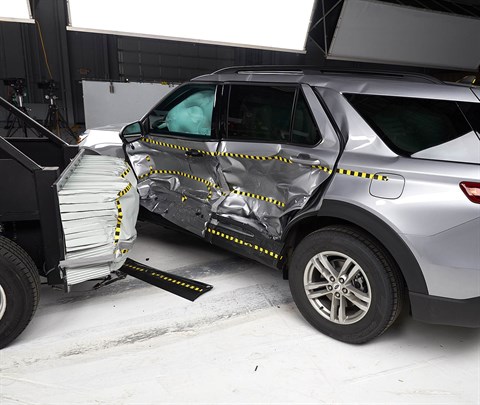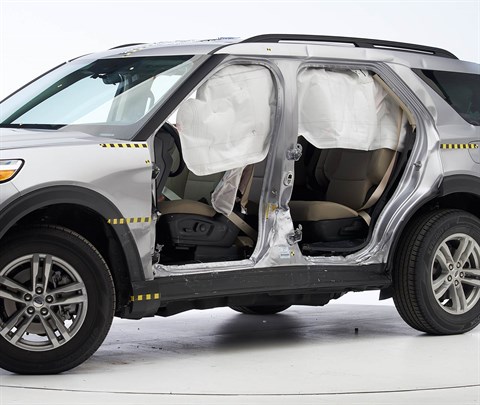Small overlap front
The small overlap front evaluation consists of a driver-side and a passenger-side component. If the results of the two evaluations differ, then the combined small overlap rating is equal to the lower rating.
Driver-side
Tested vehicle: 2020 Ford Explorer XLT 4-door 4wd
Rating applies to 2020-25 models built after May 2020
The Ford Explorer was redesigned for the 2020 model year and the Lincoln Aviator was introduced in the same model year.
Two tests of a 2020 Explorer were conducted. In the first test, forces recorded on the dummy's left lower leg were high, leading to a poor lower leg/foot injury rating and an overall acceptable rating. In response, Ford modified the left and right front subframe structure to improve occupant protection in small overlap frontal crashes beginning with cars manufactured after May 2020 (note: information about when a specific vehicle was manufactured is on the certification label typically affixed to the car on or near the driver door).
In the second test of an Explorer built after the structural modifications were in place, the lower leg/foot rating improved to acceptable and the overall rating improved to good.
| Evaluation criteria | Rating |
|---|---|
| Overall driver-side evaluation | |
| Structure and safety cage | |
| Driver injury measures | |
| Head/neck | |
| Chest | |
| Hip/thigh | |
| Lower leg/foot | |
| Driver restraints and dummy kinematics | |

Action shot taken during the second driver-side small overlap frontal crash test.

The dummy's position in relation to the door frame, steering wheel, and instrument panel after the second crash test indicates that the driver's survival space was maintained well.

Forces during the second crash contributed to a moderate risk of injury to the dummy's lower leg/foot.

The frontal and side curtain airbags worked well together to keep the head from coming close to any stiff structure or outside objects that could cause injury.
Passenger-side
Tested vehicle: 2020 Ford Explorer XLT 4-door 4wd
Rating applies to 2020-25 models built after May 2020
The Ford Explorer was redesigned for the 2020 model year and the Lincoln Aviator was introduced in the same model year. Beginning with vehicles manufactured after May 2020 modifications were made to the left and right subframe structure to improve occupant protection in small overlap frontal crashes (note: information about when a specific vehicle was manufactured is on the certification label typically affixed to the car on or near the driver door).
Passenger-side small overlap frontal ratings are assigned by the Institute based on a test conducted by Ford.
| Evaluation criteria | Rating |
|---|---|
| Overall passenger-side evaluation | |
| Structure and safety cage | |
| Passenger injury measures | |
| Head/neck | |
| Chest | |
| Hip/thigh | |
| Lower leg/foot | |
| Passenger restraints and dummy kinematics | |
| Driver injury measures | |
| Head/neck | |
| Chest | |
| Hip/thigh | |
| Lower leg/foot | |
| Driver restraints and dummy kinematics | |
Moderate overlap front: updated test
Tested vehicle: 2023 Lincoln Aviator Reserve 4-door 4wd
Rating applies to 2023-25 models
The Lincoln Aviator was introduced in the 2020 model year. These ratings do not apply to the Ford Explorer.
| Evaluation criteria | Rating |
|---|---|
| Overall evaluation | |
| Structure and safety cage | |
| Driver injury measures | |
| Head/neck | |
| Chest | |
| Thigh/hip | |
| Leg/foot | |
| Driver restraints and dummy kinematics | |
| Rear passenger injury measures | |
| Head/neck | |
| Chest | |
| Thigh | |
| Rear passenger restraints and dummy kinematics | |

View of the vehicle after the crash showing the airbags and damage to the occupant compartment.

The rear passenger dummy's head approached the front seatback, which increases the risk of head injuries.

Rear passenger dummy injury values indicate a low risk of injury to the head or neck and chest. During the crash, the shoulder belt remained in an ideal position on the dummy’s chest.

The rear passenger dummy's lap belt remained in the ideal position on the pelvis.
Side: updated test
Tested vehicle: 2022 Ford Explorer XLT 4-door 4wd
Rating applies to 2020-25 models
The Ford Explorer was redesigned for the 2020 model year and the Lincoln Aviator was introduced in the same model year.
| Evaluation criteria | Rating |
|---|---|
| Overall evaluation | |
| Structure and safety cage | |
| Driver injury measures | |
| Head/neck | |
| Torso | |
| Pelvis | |
| Driver head protection | |
| Rear passenger injury measures | |
| Head/neck | |
| Torso | |
| Pelvis | |
| Rear passenger head protection | |

View of the vehicle just after the crash test.

View of the vehicle after the crash with doors removed, showing the side airbags and damage to the occupant compartment.

Smeared greasepaint shows where the driver dummy's head was protected from being hit by hard structures by the side airbags.

Smeared greasepaint shows where the rear passenger dummy’s head was protected by the side airbag.
